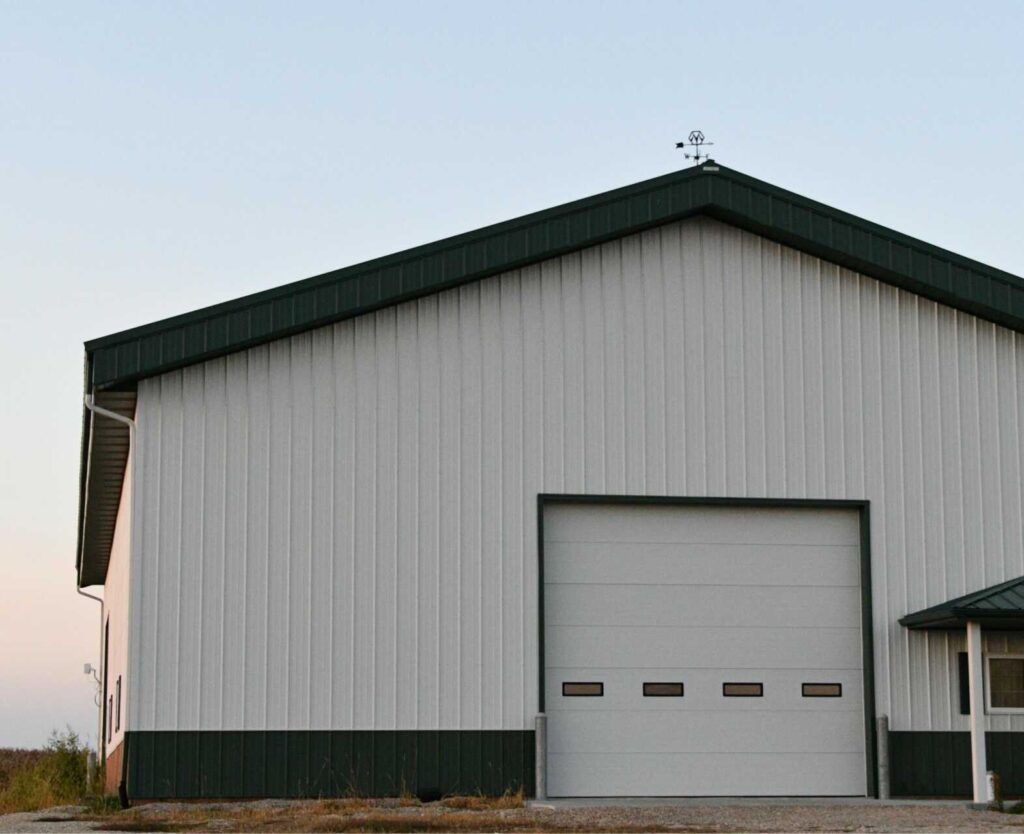
Contents
Balancing functionality with eco-friendly practices is key when it comes to lasting strategies for industrial metal buildings. From creative lighting solutions to harnessing renewable energy, the possibilities are vast. But how can these strategies benefit the environment and also your bottom line? Let’s explore how these lasting approaches can pave the way for a greener future in industrial construction.
Key Takeaways
- Incorporate energy-efficient designs for reduced energy consumption.
- Optimize natural lighting and ventilation to lower energy usage.
- Use eco-friendly insulation materials for better thermal efficiency.
- Implement rainwater harvesting systems to conserve water resources.
- Explore renewable energy sources like solar panels for sustainable power.
Energy-Efficient Lighting Solutions
Implementing energy-saving lighting solutions is necessary for maximizing sustainability in industrial metal structures. Intelligent controls play a vital role in effectively managing energy usage. Integrating smart controls into your lighting system allows you to regulate when and how lights are used, ensuring energy isn’t wasted when spaces are vacant. These controls allow for customization based on specific requirements, providing a personalized approach to lighting that improves efficiency.
Daylight utilization is another important aspect to take into account when designing lighting solutions for industrial metal structures. You can decrease dependence on artificial lighting during daylight hours by harnessing natural light through skylights, windows, or light tubes. This saves energy and enhances a more comfortable and productive work environment for occupants. Combining daylight utilization with smart controls enables a smooth shift between natural and artificial lighting sources, maintaining ideal light levels throughout the day.
Incorporating both smart controls and daylight utilization into your lighting design promotes sustainability and leads to cost savings in the long term. These strategies decrease energy usage and align with the environmentally conscious mindset of modern industrial practices.
Embracing energy-efficient lighting solutions with smart controls and daylight utilization is a significant step toward enhancing the overall sustainability of industrial metal structures.
Roofing and Insulation Innovations
You can enhance the sustainability of industrial metal buildings by incorporating green roofing materials and energy-efficient insulation systems.
Green roofing materials like solar panels or vegetative roofs can help reduce energy consumption and mitigate the urban heat island effect.
Energy-efficient insulation systems play an essential role in maintaining comfortable indoor temperatures and reducing heating and cooling costs.
Green Roofing Materials
How can the integration of green roofing materials enhance the eco-friendliness and energy efficiency of industrial metal buildings?
Utilizing environmentally friendly roofing options and sustainable landscaping solutions can have a significant impact on the overall environmental performance of your industrial metal building. Here’s how:
Enhanced Insulation: Green roofs provide natural insulation, reducing the need for excessive heating or cooling, thereby decreasing energy consumption.
Stormwater Management: These roofing materials help absorb rainwater, reducing runoff and easing the burden on drainage systems.
Improved Air Quality: Green roofs filter pollutants and CO2 from the air, promoting a healthier indoor environment for occupants.
Biodiversity Promotion: By incorporating green roofing materials, you create a habitat for plants and insects, contributing to local biodiversity and creating a more sustainable ecosystem on your building’s roof.
Embracing green roofing materials not only aligns with environmental building practices but also brings a variety of benefits that extend beyond energy efficiency, making your industrial metal building a more sustainable and eco-conscious structure.
Energy-Efficient Insulation Systems
Energy-efficient insulation systems play an essential role in optimizing the thermal performance of industrial metal buildings, greatly impacting their overall energy consumption and eco-friendliness. By incorporating green materials and focusing on thermal efficiency, these systems can significantly decrease heating and cooling costs while minimizing environmental impact.
| Advantages of Energy-Efficient Insulation Systems | Description | Benefits |
|---|---|---|
| Eco-friendly Materials | Utilizing sustainable materials like recycled content or renewable resources | Reduces carbon footprint and promotes environmental stewardship |
| Thermal Efficiency | Enhancing the building’s ability to retain heat in winter and stay cool in summer | Lowers energy bills and improves occupant comfort |
| Cost-Effectiveness | Long-term savings on energy expenses and maintenance costs | Provides a high return on investment and increases property value |
Choosing energy-efficient insulation systems fosters a more sustainable approach to industrial metal building construction and creates a comfortable and efficient space for occupants.
Solar Panel Integration for Power
Solar panels can be smoothly integrated into industrial metal buildings to harness renewable energy for power generation. By leveraging solar panel integration, industrial metal buildings can reduce their reliance on non-renewable energy sources, leading to long-term cost savings and environmental benefits.
Here are some key points worth noting:
Cost-Effectiveness: Solar panel integration provides a cost-efficient solution for industrial metal buildings to generate their electricity, reducing utility bills and offering a quick return on investment.
Energy Independence: By installing solar panels, industrial metal buildings can enhance their energy independence, decreasing their reliance on the traditional power grid and mitigating the impact of power outages.
Battery Storage: Incorporating battery storage systems alongside solar panels allows industrial metal buildings to store excess energy generated during peak sunlight hours for later use, ensuring a continuous power supply even during low-light periods or at night.
Net Metering: Through net metering programs, industrial metal buildings can feed excess electricity produced by their solar panels back into the grid, receiving credits on their utility bills and further enhancing the financial benefits of solar panel integration.
Rainwater Harvesting Systems
Implementing rainwater collection systems in industrial metal buildings offers an eco-friendly method for gathering and using rainwater resources efficiently. Water conservation methods like rainwater collection play an important role in eco-friendly building practices. By capturing rainwater from the building’s roof through a system of gutters and downspouts, the gathered water can be stored in tanks for various non-potable uses within the building, such as irrigation, cooling systems, and even flushing toilets.
Greywater recycling, which involves reusing wastewater from sinks, showers, and laundry, can be integrated into the rainwater collection system to further reduce water consumption. This dual approach maximizes water efficiency within industrial metal buildings, promoting a more eco-friendly water management strategy.
In addition to rainwater collection, incorporating drought-resistant landscaping and permeable paving around industrial metal buildings can help minimize water usage and prevent runoff. Drought-resistant plants require less water, reducing the need for irrigation, while permeable paving allows rainwater to infiltrate the ground, replenishing groundwater sources and reducing strain on stormwater systems.
Recycled Materials in Construction
To enhance durability in industrial metal buildings, contemplate integrating reclaimed materials in construction to minimize environmental impact and promote resource conservation. By utilizing waste reduction techniques and eco-friendly design principles, you can contribute to a more environmentally conscious construction process. Embracing circular economy practices and eco-sourcing of materials further enhances the overall durability of the building.
When it comes to integrating reclaimed materials into the construction of industrial metal buildings, there are several key benefits to ponder:
Reduced Environmental Impact: By reusing materials that would otherwise end up in landfills, you’re helping to mitigate the depletion of natural resources and reduce energy consumption associated with traditional manufacturing processes.
Cost Savings: Using reclaimed materials can often be a more cost-effective solution compared to purchasing new materials, helping you save on construction expenses.
Improved Energy Efficiency: Reclaimed materials are often more energy-efficient to produce, contributing to lower carbon emissions and a more durable building overall.
Promotion of Sustainable Practices: By incorporating reclaimed materials, you’re actively promoting and supporting sustainable practices within the construction industry, setting a positive example for future projects.
Green Landscaping for Metal Buildings
How can eco-friendly landscaping practices be effectively integrated to improve the long-term viability of metal buildings?
Environmentally conscious landscaping plays an essential role in the overall eco-conscious design of metal buildings. By integrating green building practices into the surrounding areas of metal structures, you can make a significant contribution to environmental solutions and establish a more enduring ecosystem.
One key aspect of eco-friendly landscaping for metal buildings is the use of indigenous plants. These plants are well-suited to the local climate and require minimal water and upkeep once established. By selecting indigenous vegetation, you can decrease the need for irrigation and chemical inputs, thereby fostering a more enduring landscape.
In addition to planting native species, incorporating green roofs and walls can further enhance the sustainability of metal buildings. Green roofs provide insulation, reduce energy consumption for heating and cooling, manage stormwater runoff, and enhance air quality. Green walls offer similar advantages, serving as natural air purifiers and boosting the visual appeal of the building.
Review
To sum up, long-term strategies for industrial metal buildings include:
- Energy-efficient lighting solutions
- Roofing and insulation innovations
- Solar panel integration for power
- Rainwater harvesting systems
- Recycled materials in construction
- Green landscaping
These strategies offer a practical path to promoting environmental stewardship and cost savings.
By implementing these initiatives, industrial metal buildings can enhance their efficiency, reduce their environmental impact, and reinforce their resilience for the future.
Recent Posts
What Are the Benefits of Tailored Metal Structures?
Imagine a well-crafted suit tailored to fit perfectly; that’s how tailored metal structures operate in
3 Tips for Long-lasting Metal Commercial Structures
When it comes to metal commercial structures, you’ll want to focus on a few key
Explore Benefits of Residential Metal Structures
It’s funny how you might stumble upon the idea of residential metal structures just when




